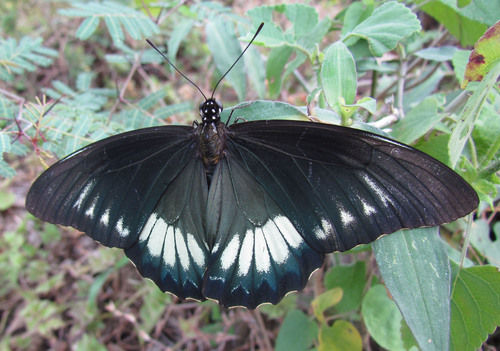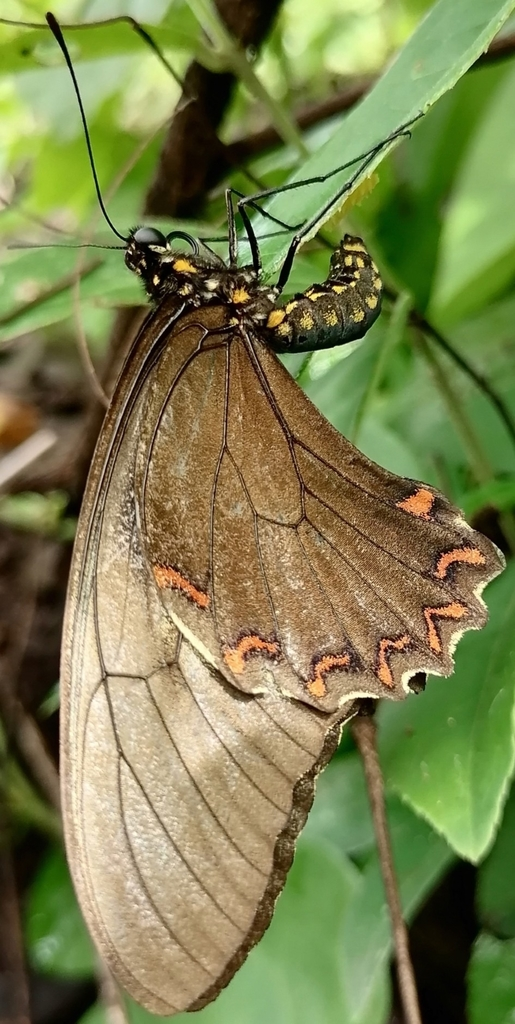Battus laodamas gets its Latin name from two minor characters in ancient literature, and its English and Spanish names from its color. There are different subspecies of B. laodamas. Some look like a solid green patch--black or dark brown in a dim light, they look iridescent green in the sun--and some have smaller patches of brighter or lighter green. All can fairly be described as Green Patch, or parche verde.
Who was Laodamas and why was a butterfly named after him? Ancient Greek literature mentions five men called Laodamas, each one a minor character in a different story. The reason why a butterfly was named after him is probably that it was traditional to name Swallowtails after characters in ancient literature, and other names were taken.
In addition to the genus Battus having been sorted out of the genus Papilio, laodamas has also been called chrysodamas, chromealus, or procasi. Two of those names call attention to the way the lighter spots on the underside of the greenish wings can often be bright golden yellow. They can also be red, white, or pale green. Some call it "yellow-marked" in English, too. But the marks aren't always yellow. Martin Reid opens a lovely photo essay with a photo of a Green Patch that looks black-and-white in indirect light:
ButterfliesOfAmerica has pages for the four subspecies that are generally recognized. Basically, in the West Mexican subspecies iopas the patch of lighter color on the upper side of the hind wings forms a broad stripe across the wings when the butterfly spreads them in flight, in the East Mexican and Central American subspecies copanae they form more of a broken ring, in the south-Central American subspecies rhipidius they form two almost eye-shaped spots, and in the nominate subspecies laodamas, found in Colombia, they curve down from a bar across the front of the hind wings...except that, in each subspecies some individuals' markings are close to fitting the descriptions of each of the other subspecies', and some individuals don't show these markings at all.
The species was first named and described by C. and R. Felder in 1859, in German. By 1906, when more was known, Walter Rothschild was able to describe the subspecies here, noting at that time nothing at all was known about the early stages or life cycle. Rothschild favored the name procas over iopas, though he lists both names for the same subspecies. Some sources still call this subspecies procas today.
When the green shows, it's often subtle, an effect of only some light. Jorgevargasramirez donated to INaturalist a six-photo series showing how the color of the individual licking his hand changed at different angles to the light. He met his little friend in August, he says. What he did to make his hand so appealing to a butterfly of normally clean habits, he does not say.
Some male Swallowtails do like the mineral salts in human sweat. They don't usually make themselves pests about it, but if you sit still on a hot day, perspiring freely, they'll perch on you and slurp up salty flavor. Females usually aren't attracted to salt tastes. They prefer to sip flower nectar or fruit juice and absorb the salt they need through contact with their mates. Sometimes one does see an unmated female Swallowtail taking a savory drink from a puddle--a sad sight, indicating that the local population may be endangered. Or the lonely female may have been separated from her community, as it might have been by a storm or a child who wanted to keep her as a pet, and be stranded in a place where her species has no population.
It seems to be rare for a photographer to catch a living laodamas at the moment when sunshine on those iridescent wings really makes the colors pop...
Sierraeco documents that it is the light. (Sierraeco took four photos of this butterfly; he was completely male, and in equally indirect light his wings matched.) Well done!
This species is known widely but not well. Even Jeffrey Glassberg's Swift Guide to the Butterflies of Mexico and Central America has nothing to say about it beyond a few pictures showing how to tell it from other Battus--it doesn't have as many red spots around the edge of the underside of the hind wing as ingenuus has. On the wing it looks pretty similar to other Battus, actually, which may be why so little is known about it.
It is found in Mexico, Central America, and the northern part of South America, where it's easily recognized but not common. Images of it are sometimes sold as souvenirs. So, unfortunately, are dead bodies, for which regular readers know by now we should never pay.
It's not found in the African nation of Sao Tome e Principe, but that country has celebrated it with a painting on a postage stamp:
It belongs to the swallowtail family even though, like other South American Battus species, it does not have the "swallow tails" on its hind wings. Mexican sources seem to emphasize that the family are de cola de golondrina although these butterflies actually have no feature resembling the tail of the golondrina, or swallow bird.
The average wingspread is about three and a half inches. Although human observers don't mention noticing its scent, males' hind wings show scent folds, little wrinkles of scaleless skin that release their distinctive odor as they fly. To one another they probably smell good.
Caterpillars eat the leaves of vines in the genus (you'll never guess!) Aristolochia. Mother butterflies lay eggs on the undersides of Aristolochia vines:
Photo by Jorgevargasramirez, who found this yellow-marked lovely laying eggs on the last day of August.
The eggs are a bright warning yellow color, and the butterfly doesn't have to be especially careful to place each egg on a separate leaf.
The caterpillars aren't very colorful. Note that, although this photo by Crake shows the light reflecting on the back of the caterpillar's head, its "helmet" only looks like the bright dark eyes of a larger animal that might eat birds. The working eyes are closer to the mouth, seldom seen by humans.
By human standards all caterpillars are extremely nearsighted, enough to be classified as "legally blind." They show little evidence of an ability to see anything a yard away from their heads and almost no indication that they see anything ten feet away. This is one of many things that change when they become butterflies; adult butterflies seem to have excellent vision.
Adult butterflies pollinate flowers. Two genera they are known to like are Bauhinia and Caesalpinia.








No comments:
Post a Comment